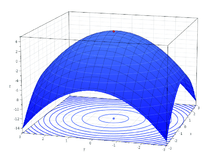Fourier–Motzkin elimination
Fourier–Motzkin elimination, also known as the FME method, is a mathematical algorithm for eliminating variables from a system of linear inequalities. It can output real solutions.
The algorithm is named after Joseph Fourier and Theodore Motzkin.
Elimination
The elimination of a set of variables, say V, from a system of relations (here linear inequalities) refers to the creation of another system of the same sort, but without the variables in V, such that both systems have the same solutions over the remaining variables.
If all variables are eliminated from a system of linear inequalities, then one obtains a system of constant inequalities. It is then trivial to decide whether the resulting system is true or false. It is true if and only if the original system has solutions. As a consequence, elimination of all variables can be used to detect whether a system of inequalities has solutions or not.
Consider a system  of
of  inequalities with
inequalities with  variables
variables  to
to  , with
, with  the variable to be eliminated. The linear inequalities in the system can be grouped into three classes depending on the sign (positive, negative or null) of the coefficient for
the variable to be eliminated. The linear inequalities in the system can be grouped into three classes depending on the sign (positive, negative or null) of the coefficient for  .
.
- those inequalities that are of the form
 ; denote these by
; denote these by  , for
, for  ranging from 1 to
ranging from 1 to  where
where  is the number of such inequalities;
is the number of such inequalities; - those inequalities that are of the form
 ; denote these by
; denote these by  , for
, for  ranging from 1 to
ranging from 1 to  where
where  is the number of such inequalities;
is the number of such inequalities; - those inequalities in which
 plays no role, grouped into a single conjunction
plays no role, grouped into a single conjunction  .
.
The original system is thus equivalent to
 .
.
Elimination consists in producing a system equivalent to  . Obviously, this formula is equivalent to
. Obviously, this formula is equivalent to
 .
.
The inequality
is equivalent to  inequalities
inequalities  , for
, for  and
and  .
.
We have therefore transformed the original system into another system where  is eliminated. Note that the output system has
is eliminated. Note that the output system has  inequalities. In particular, if
inequalities. In particular, if  , then the number of output inequalities is
, then the number of output inequalities is  .
.
Complexity
Running an elimination step over  inequalities can result in at most
inequalities can result in at most  inequalities in the output, thus running
inequalities in the output, thus running  successive steps can result in at most
successive steps can result in at most  , a double exponential complexity.
This is due to the algorithm producing many unnecessary constraints (constraints that are implied by other constraints). The number of necessary constraints grows as a single exponential.[1]
Unnecessary constraints may be detected using linear programming.
, a double exponential complexity.
This is due to the algorithm producing many unnecessary constraints (constraints that are implied by other constraints). The number of necessary constraints grows as a single exponential.[1]
Unnecessary constraints may be detected using linear programming.
See also
- Real closed field: the cylindrical algebraic decomposition algorithm performs quantifier elimination over polynomial inequalities, not just linear.
References
- ↑ David Monniaux, Quantifier elimination by lazy model enumeration, Computer aided verification (CAV) 2010.
- Fourier, Joseph (1827). "Histoire de l'Académie, partie mathématique (1824)". Mémoires de l'Académie des sciences de l'Institut de France 7. Gauthier-Villars.
- Schrijver, Alexander (1998). Theory of Linear and Integer Programming. John Wiley & sons. pp. 155–156. ISBN 0-471-98232-6.
- Keßler, Christoph W. "Parallel Fourier–Motzkin Elimination". Universität Trier. CiteSeerX: 10
.1 ..1 .54 .657 - Williams, H. P. (1986). "Fourier's Method of Linear Programming and its Dual". American Mathematical Monthly 93 (9): 681–695. doi:10.2307/2322281.
External links
- Lectures on Convex Sets, notes by Niels Lauritzen, at Aarhus University, March 2010.
| |||||||||||||||||||||||||||||||||||||||||||||||||||||||||||||||||||||||||||||||||||||||||||||||||||||||||||||

